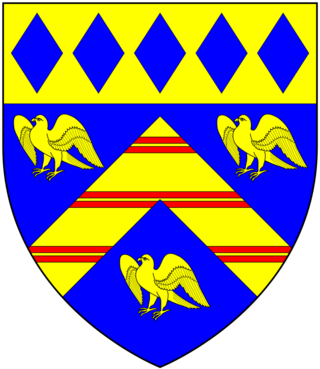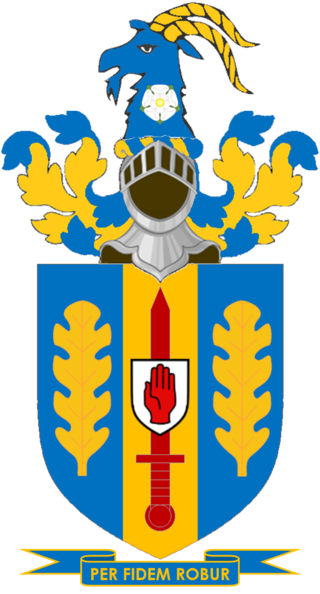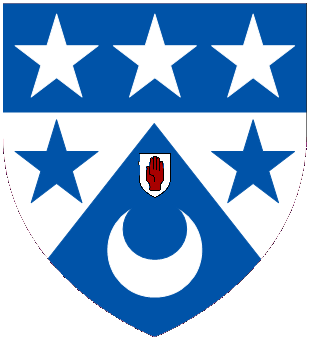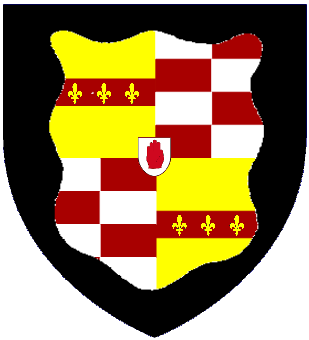
The Lawson baronetcy, of Knavesmire Lodge in the City of York, was created in the Baronetage of the United Kingdom on 26 December 1905 for the politician John Lawson. The title became extinct on the death of the 2nd Baronet in 1973.

The Lawson baronetcy, of Knavesmire Lodge in the City of York, was created in the Baronetage of the United Kingdom on 26 December 1905 for the politician John Lawson. The title became extinct on the death of the 2nd Baronet in 1973.

Viscount Hardinge, of Lahore and of Kings Newton in the County of Derby, is a title in the Peerage of the United Kingdom. It was created in 1846 for the soldier and Tory politician Sir Henry Hardinge. His son, the second Viscount, represented Downpatrick in Parliament. His great-great-grandson, the sixth Viscount, succeeded a distant relative as eighth Baronet, of Belle Isle in the County of Fermanagh, in 1986. This title had been created in the Baronetage of the United Kingdom 1801 for Richard Hardinge. He was the third son of Nicolas Hardinge, younger brother of Reverend Henry Hardinge and uncle of the latter's third son Henry Hardinge, 1st Viscount Hardinge. The baronetcy was created with special remainder to the heirs male of Richard Hardinge's father.

Baron Avebury, of Avebury in the County of Wiltshire, is a title in the Peerage of the United Kingdom. It was created 22 January 1900 for the banker, politician and archaeologist Sir John Lubbock, 4th Baronet. He was succeeded by his eldest son, the second Baron. On his death the titles passed to his nephew, the third Baron. He was the son of Harold Fox Pitt Lubbock, fourth son of the first Baron, who died in 1971. The title then passed to the third Baron's first cousin, the fourth Baron, the son of Maurice Fox Pitt Lubbock, sixth son of the first Baron. The fourth baron was a Liberal Democrat politician and one of the ninety excepted hereditary peers who remained in the House of Lords after the passing of the House of Lords Act 1999. He was succeeded by his son, the fifth Baron, in 2016.

Baron Roborough, of Maristow in the County of Devon, is a title in the Peerage of the United Kingdom. It was created on 24 January 1938 for Sir Henry Lopes, 4th Baronet. He had earlier represented Grantham, Lincolnshire, in Parliament as a Conservative. The Baronetcy, of Maristow House in the County of Devon, had been created in the Baronetage of the United Kingdom on 1 November 1805 for Manasseh Masseh Lopes, a member of a wealthy family of Portuguese Jewish origin, with special remainder to his nephew Ralph Franco, son of his sister Maria. Manasseh Masseh Lopes converted to Christianity in 1802, and later represented Evesham, in Worcestershire, Barnstaple in Devon, and Westbury in Somerset, in Parliament. However, in 1819 he was twice convicted of bribing the voters in both Barnstaple and Grampound in order to be elected to Parliament, and was sentenced to imprisonment and heavy fines. He was also unseated by the House of Commons, but after his release from prison he nonetheless got elected for Westbury, a pocket borough which he controlled to a great extent.

The Ackroyd Baronetcy, of Dewsbury in the West Riding of the County of York, is a title in the Baronetage of the United Kingdom. It was created on 5 July 1956 for Cuthbert Ackroyd, Lord Mayor of London between 1955 and 1956.

The Arnott Baronetcy, of Woodlands in the Parish of St Anne, Shandon in the County of Cork, is a title in the Baronetage of the United Kingdom. It was created on 12 February 1896 for the Irish entrepreneur and philanthropist John Arnott.

The Austin Baronetcy, of Red Hill in the parish of Castleford in the West Riding of the County of York, is a title in the Baronetage of the United Kingdom. It was created on 16 July 1894 for John Austin, Liberal member of parliament for Osgoldcross.
The Madden Baronetcy, of Kells, County Kilkenny, is a title in the Baronetage of the United Kingdom. It was created in 1919 for the naval commander, Admiral Sir Charles Madden. He was succeeded by his son, the second Baronet, who was also a distinguished naval officer and served as Commander-in-Chief of the Home Fleet between 1963 and 1965.

The Barrett-Lennard Baronetcy, of Belhus in the County of Essex, is a title in the Baronetage of the United Kingdom. It was created on 30 June 1801 for Thomas Barrett-Lennard, subsequently Member of Parliament for Essex South. He was the illegitimate son and testamentary heir of Thomas Barrett-Lennard, 17th Baron Dacre. He was succeeded by his grandson, the second Baronet, the son of Thomas Barrett-Lennard, Member of Parliament for Maldon. His son, the third Baronet, was childless and was succeeded by his younger brother, the fourth Baronet. This line of the family failed on the death in 1977 of his son, the fifth Baronet, who died without male issue. The late Baronet was succeeded by his third cousin once removed, the sixth Baronet. He was the son of Sir Fiennes Cecil Arthur Barrett-Lennard, Chief Justice of Jamaica, son of Captain Thomas George Barrett-Lennard, son of the first marriage of George Barrett-Lennard, son of John Barrett-Lennard, second son of the first Baronet. The sixth Baronet was a Catholic clergyman. As of 2014 the title is held by his second cousin, the seventh Baronet, who succeeded in 2007. He is the grandson of Trenchard Barrett-Lennard, son of the aforementioned George Lennard-Barrett by his second marriage. As of 31 December 2013 the present Baronet has not successfully proven his succession and is therefore not on the Official Roll of the Baronetage, with the baronetcy considered vacant since 2007.

There have been two baronetcies created for the Guise family, one in the Baronetage of England and one in the Baronetage of Great Britain. The latter creation is extant as of 2014.

The Gibson, later Gibson-Carmichael, later Gibson-Craig-Carmichael Baronetcy, of Keirhill in the County of Edinburgh, is a title in the Baronetage of Nova Scotia. It was created on 31 December 1702 for Thomas Gibson, with remainder to his heirs male. The sixth Baronet assumed the additional surname of Carmichael. The eleventh Baronet was a Liberal politician. In 1912, he created Baron Carmichael, of Skirling in the County of Peebles, in the Peerage of the United Kingdom. The barony died in 1926, while he was succeeded in the baronetcy by his kinsman Sir Henry Thomas Gibson-Craig-Carmichael, 5th Baronet, of Riccarton, who became the twelfth Baronet of Keirhill and assumed the additional surname of Carmichael.

The Crisp Baronetcy, of Bungay in the County of Suffolk, is a title in the Baronetage of the United Kingdom, created on 5 February 1913 for lawyer and microscopist Sir Frank Crisp.
The Hartwell Baronetcy, of Dale Hall in the County of Essex, is a title in the Baronetage of the United Kingdom. It was created on 26 October 1805 for Admiral Francis Hartwell.

The Hervey-Bathurst baronetcy, of Lainston in the County of Southampton, is a title in the Baronetage of the United Kingdom. It was created on 7 December 1818 for Felton Hervey-Bathurst, with remainder, failing heirs male of his own, to the heirs male of his father. Hervey-Bathurst was the grandson of the Hon. Felton Hervey, seventh son of John Hervey, 1st Earl of Bristol, and served as an Aide-de-Camp to the Duke of Wellington after the Battle of Waterloo.

The Smith, later Smith-Marriott Baronetcy, of Sydling St Nicholas in the County of Dorset, is a title in the Baronetage of Great Britain. It was created on 1 June 1774 for John Smith, High Sheriff of Dorset in 1772. The second Baronet married Elizabeth Anne, daughter of Reverend James Marriott. The fourth Baronet assumed by Royal sign-manual the additional surname of Marriott. The fifth Baronet was High Sheriff of Dorset in 1873.

The Buckworth, later Buckworth-Herne, later Buckworth-Herne-Soame Baronetcy, of Sheen in the County of Surrey, is a title in the Baronetage of England. It was created on 1 April 1697 for John Buckworth, High Sheriff of London in 1704. The second Baronet sat as Member of Parliament for Weobley. The third Baronet was Assistant Gentleman Usher to George II. The fifth Baronet was Gentleman-Pensioner and Exon of the Guard during the reign of George III. He married Anne, daughter of Paston Herne, of Haveringland Hall, Norfolk, and assumed by Royal licence the additional surname of Herne. The sixth Baronet assumed in 1806 by Royal licence the additional surname of Soame in compliance with the will of Sir Peter Soame, 4th Baronet, of Thurlow. The ninth Baronet was a member of the Shropshire County Council.

The Erskine baronetcy, of Cambo in the County of Fife, was created in the Baronetage of the United Kingdom on 27 August 1821 for David Erskine, a grandson through an illegitimate line of Thomas Erskine, 9th Earl of Kellie. The original baronetcy of Cambo became extinct on the death of the tenth Earl of Kellie in 1829.

The Jones baronetcy, of Treeton in the County of York, was created in the Baronetage of the United Kingdom on 23 May 1919 for the Yorkshire industrialist Frederick Jones. His son, the 2nd Baronet, was also a businessman. The family seat is Irnham Hall in Irnham, Lincolnshire.

The Lawson baronetcy, of Brayton in the County of Cumberland, was created in the Baronetage of the United Kingdom on 30 September 1831 for Wilfrid Lawson. Born Wilfrid Wybergh, he was the son of Thomas Wybergh by the sister of the 10th Baronet of the 1688 creation. He assumed by Royal licence the surname of Lawson in lieu of Wybergh.

The Lawson, later Howard-Lawson baronetcy, of Brough Hall in the County of York, was created in the Baronetage of the United Kingdom on 8 September 1841 for William Lawson. Born William Wright, he was the son of John Wright, of Kelvedon, by Elizabeth Lawson, daughter of the 5th Baronet of the 1665 creation whose surname he assumed in lieu of his Wright. His mother had previously inherited the Lawson family seat of Brough Hall.

The Lawson baronetcy, of Weetwood Grange in Headingley-cum-Burley in the West Riding of the County of York, was created in the Baronetage of the United Kingdom on 12 July 1900 for Arthur Lawson, Chairman of Fairbairn Lawson Combe Barbour Ltd, and a Director of the Great Eastern Railway and the Yorkshire Post.